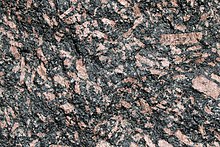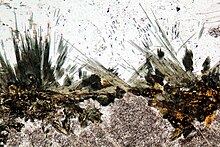

Luxullianite (also known as luxulyanite or luxulianite) is a rare type of porphyritic tournalinized granite, notable for the presence of clusters of radially-arranged acicular tourmaline crystals enclosed by phenocrysts of orthoclase and quartz in a matrix of quartz, tourmaline, alkali feldspar, brown mica, and cassiterite.
The name originates from the village of Luxulyan in Cornwall, United Kingdom, where this type of granite is found. An example may be seen in the Duke of Wellington's tomb in St Paul's Cathedral in London. Some luxullianite is also used in the Porphyry Hall of the Place House in Fowey.
References
- Lobley, J. Logan (1892). "Building stones, their structure and origin". Stone: an Illustrated Magazine. V (June–November): 46. Retrieved 1 January 2023.
- Bristow, C.M. (2001). "Some notable Cornish building and decorative stones" (PDF). Geoscience in South-West England. pp. 223–229. Retrieved 26 December 2024.
External links
This article related to petrology is a stub. You can help Misplaced Pages by expanding it. |